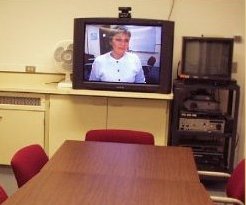| Clinical Consultation | ||
| Inservice |
Getting Started
| Equipment and Preparation |
||
| Set Up Procedures | ||
| Example Forms |
 A
large room teleconferencing system that is properly set up and well designed
is very easy to use. You just go about your meeting business and talk
to the large TV set when addressing the participants at the other end.
A
large room teleconferencing system that is properly set up and well designed
is very easy to use. You just go about your meeting business and talk
to the large TV set when addressing the participants at the other end.
At times it works best to have one person responsible for zooming the camera to focus in on a speaker, but often the purpose of a room system is to have a group of people talk to one individual at the other end.
The audio is often the most critical piece of a room system and having a high quality microphone that covers the room is critical for success. When buying a microphone, particularly for a conference room where there will be several speakers/participants, don't scrimp!
Another improvement that can be made to room systems is the use of acoustical wall panels or some other type of sound barriers that will block noise and reduce echo. Such panels need only be placed on two adjacent walls in a room to provide adequate improved sound in a room.
Most lighting in a room system is overhead fluorescent tubes. Though these are often adequate, lighting can be improved by replacing the fluorescent tubes with full spectrum tubes. These special fluorescent tubes will provide a more natural color of light and improve the appearance of everyone in the room. Rooms that don't meet the standards outlined above can lead to poor videoconferencing experiences.
Introduction | Types of Videoconferencing | Technical Issues | Getting Started | Examples | Resources | Home